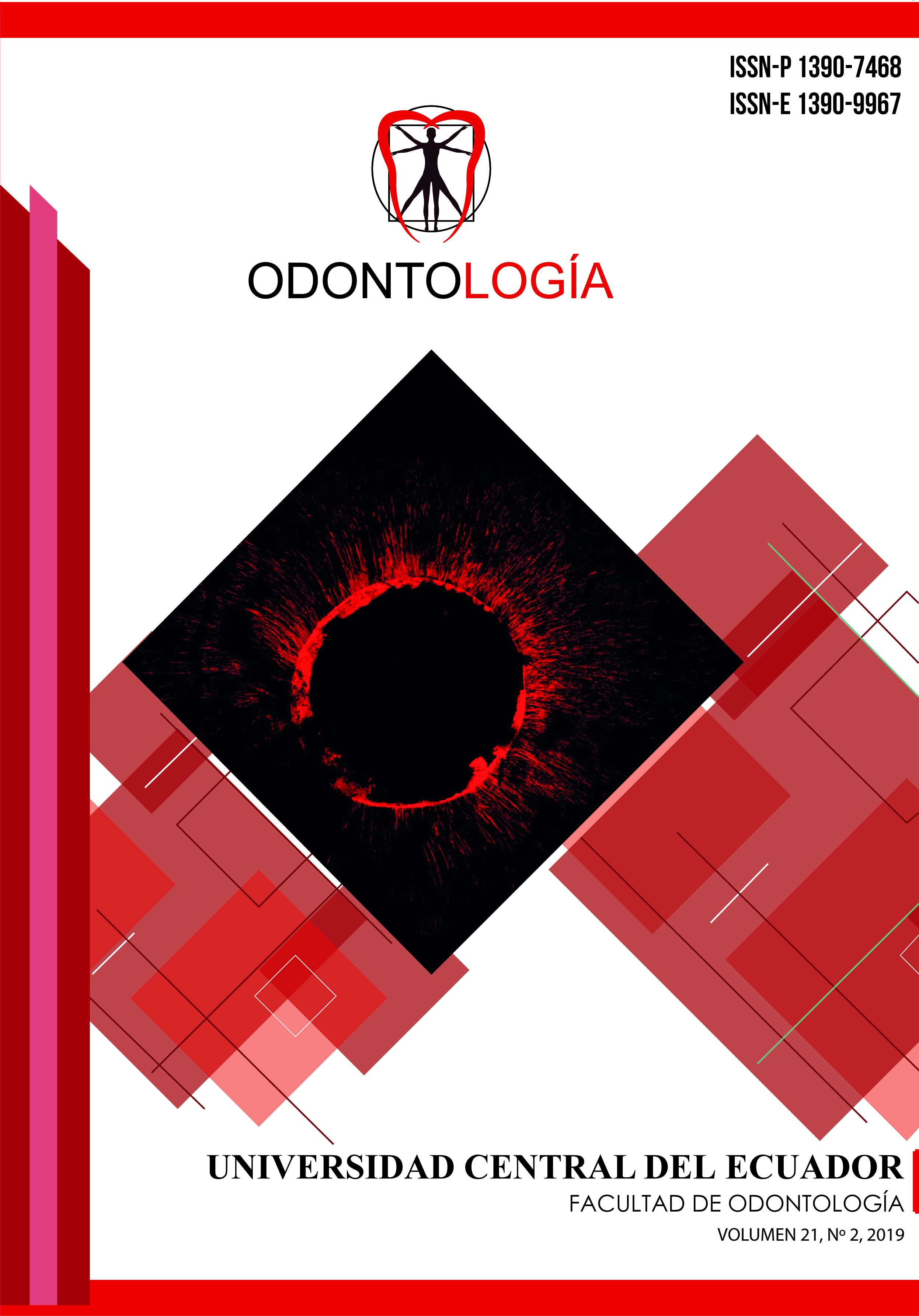Corticotomia selectiva y ortodoncia: distancia y tiempo en que se logra realizar un desplazamiento. Revisión bibliografica
DOI:
https://doi.org/10.29166/odontologia.vol21.n2.2019-114-122Palabras clave:
Ortodoncia, Osteotomía, Hueso Cortical, Remodelación Ósea, Tiempo de TratamientoResumen
La corticotomía se define como una osteotomía, en la cual, se corta el hueso cortical, perforando o alterando mecánicamente de una manera quirúrgica controlada y al mismo tiempo penetrando mínimamente en la médula ósea para acelerar el movimiento dental ortodóntico en respuesta a una demanda de los pacientes en cuanto a la efectividad del tratamiento y al rápido movimiento de cada zona. Objetivo: Mediante una revisión bibliográfica, determinar la distancia y tiempo en que se logra llevar a cabo un desplazamiento o movimiento ortodóntico después de haber realizado una corticotomía selectiva. Para la búsqueda, se utilizaron plataformas como Pubmed, Scielo, Science Direct y Google Scholar, en las que se empleó palabras claves como distancia, tiempo, corticotomía selectiva y tratamiento de ortodoncia y se buscaron artículos publicados entre el 2001 y 2017. Resultados: se obtuvo que los movimientos se realizan en un periodo de 4 meses, respecto a la distancia y se observó que se logra desplazar un promedio de 3.5 mm. Conclusiones: En pacientes adultos, ha aumentado la exigencia sobre reducir tiempos de tratamiento, la ortodoncia facilitada por corticotomía consigue llevar a cabo un tratamiento exitoso y disminuir los tiempos de tratamiento. Sin embargo, la evidencia es escasa, pues está basada principalmente en reportes de casos, por lo cual se requiere mayor investigación acerca de este procedimiento. acerca de este procedimiento.
Descargas
Citas
Bhattacharya P. Assessment of corticotomy facilitated tooth movement and changes in alveolar bone thickness - A CT Scan study. Journal of Clinical and Diagnostic Research. 2014 Octubre; 8(10).
Murphy H. Periodontal Accelerated osteogenic orthodontics: a description of the surgical technique. J Oral maxillofac surg. 2009; 67(21).
Wilcko WM WTBJFD. Rapid orthodontics with alveolar reshaping: two case reports of decrowding. Int J periodont Restorat Dent. 2001; 21(1).
Burrow. S. Biomechanics and the paradigm shift in orthodontic treatment plannin. J Clin Orthod. 2009; 43(10).
Dibart S S. Piezocision: a minimally invasive, periodontally accelerated orthodontic tooth movement procedure. Practical Osseous Surgery in Periodontics and Implant Dentistry. 2011;(195).
Dibart S S. Piezocision: a minimally invasive, periodontally accelerated orthodontic tooth movement procedure. Practical Osseous Surgery in Periodontics and Implant Dentistry. 2011;(195).
Nowzari YH. Periodontally accelerated osteogenic orthodontics combined with autogenous bone. Compend contin Educ Dent. 2008; 29.
Samuel Salvador Robles Andrade CGCCHH. Ortodoncia acelerada periodontalmente: Fundamentos biológicos y técnicas quirúrgicas. Revista Mexicana de Periodontología. 2011 abril; 2(1).
Arango JDCMR. Comparación Clínica entre el tratatmiento ortódontico facilitado por corticotomia y ortodoncia convencional. Int. J odontostomat. 2015; 9(2).
Akay M AAGTASKB. Enhanced effect of combined treatment with corticotomy and skeletal anchorage in open bite correction. J Oral Maxillofac Surg. 2009;(67).
Dubravko Pavlin DMD MPD,RAMVRDMPTGDPD. Cyclic Loading (Vibration) Accelerates Tooth Movement in Orthodontic Patients: A Double-Blind, Randomized Controlled Trial, Semin Orthod. http://dx.doi.org/10.1053/j.sodo.2015.06.005. .
Düker I. experimental animal research into segmental alveolar movement after corticotomy. J Maxillofac Surg. 1975; 3.
Shoichiro L SSGITNTISM. Acceleration of orthodontic tooth movement by alveolar corticotomy in the dog. Am J Orthod Dentofacial Orthop. 2007; 131(4).
L Soichiro SSMS. An adult bimaxillary protrusion treated with corticotomy-facilitated orthodontics and titanium miniplates. Angle orthodontist. 2006; 76(6).
Sumit Yadav aTDAAHGZKaRNFC. Effect of low-frequency mechanical vibration on orthodontic tooth movement.. Am J Orthod Dentofacial Orthop. 2015 Sep; 148(3).
Wilcko M. accelerated osteogenic orthodontics technique: a 1- stage surgically facilitated rapid orthodontic technique with alveolar augmentation. J oral maxillofac surg.. 2009; 67(10).
Yamasaki K SYISTYSYFT. Clinical application of prostaglandin E1 (PGE1) upon orthodontic tooth movement. American Journal of Orthodontics and Dentofacial Orthopedics. 1984; 85.
Pavlin D ZRGHJ. Temporal pattern of stimulation of osteoblast-associated genes during mechanically-induced osteogenesis in vivo: Early responses of osteocalcin and type I collagen. Connective Tissue Research. 2001; 42.
Pavlin D MMZRGEGHJ. Orthodontically stressed periodontium of transgenic mouse as a model for studying mechanically induced gene regulation in bone: The effect on the number of osteoblasts. Clinical Orthododontics and Research. 2000; 3.
Rubin C TSMRMEMKLWaQY. Quantity and quality of trabecular bone in the femur are enhanced by a strongly anabolic, noninvasive mechanical intervention. J Bone and Mineral Research. 2002; 17(2).
Rubin J RCJC. Molecular pathways mediating mechanical signaling in bone.. Gene. 2006; 367.
Gluhak-Heinrich J YLBLFJMMHSPD. Mechanical loading stimulates dentin matrix protein 1 (DMP1) in osteocytes in vivo. Journal of Bone and Mineral Research. 2003; 18.
Andrade MSR. Ortodoncia celerada periodontalmente: fundamentos biológicos técnicas quirúrgicas. Revista mexicana de peridiodontología. 2011 abril; 2(1).
Kawasaki K SN. Effects of low-energy laser irradiation on bone remodeling during experimental tooth movement in rats. Lasers in Surgery and Medicine. 2000; 26.
Stark TM SP. Effect of pulsed electromagnetic fields on orthodontic tooth movement. American Journal of Orthodontics and Dentofacial Orthopedics. 1987;(91).
Takano-Yamamoto T KMYT. Effect of age on the rate of tooth movement in combination with local use of 1,25(OH)2D3 and mechanicalforce in the rat. Journal of Dental Research. 1992; 71.
Motohashi T NMKK. Biomechanical efffects of orthodontic treatment by using anchorage device combined with corticotomy. Journal of Cranio-Maxillofacial Surgery.. 2006; 34(1).
Vercellotti TP. Orthodontic microsurgery: a new surgically guided technique for dental movement. Int J periodontics Restorative Dent. 2007; 27.
Köle H. Surgical operations of the alveolar ridge to correct occlusal abnormalities. Oral Surg Oral Med Oral Pathol. 1959; 12(3).
Frost H. The regional acceleratory phenomenom: a review. Henry Ford Hosp Med J. 1983; 31(1).
Kanno T MMFYKSAN. Corticotomy and compression osteogenesis in the posterior maxilla for treating severe anterior open bite. Int J Oral Maxillofacial Surg. 2007;(4).
Oliveira D OBAHGSMP. Selective alveolar corticotomy to intrude overerupted molars. Am J Orthod Dentofacial Orthop. 2008; 133.
Rubin C JSQY. Low-level mechanical signals and their potential as a non-pharmacological intervention for osteoporosis. Age and Ageing. 2006; 35(S2).
Pavlin D GHJ. Effect of mechanical loading on periodontal cells. Critical Reviews in Oral Biology and Medicine. 2001; 12.
Publicado
Cómo citar
Número
Sección
Licencia
Derechos de autor 2020 Héctor Eduardo Méndez Zapata, José Angel Lonato Ponce, Jelsyka Quirós Castillo

Esta obra está bajo una licencia internacional Creative Commons Atribución-NoComercial-SinDerivadas 4.0.


